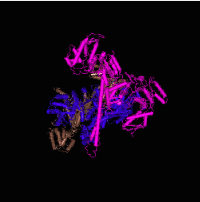| Detailed family information | Detailed matrix information | Tissue |
|---|
| GC-Box factors SP1/GC | Stimulating protein 1, ubiquitous zinc finger transcription factor | Ubiquitous |
| Peroxisome proliferator-activated receptor | Peroxisome proliferator-activated receptor gamma, DR1 sites | Adipose Tissue, Connective Tissue, Digestive System, Liver |
| MYT1 C2HC zinc finger protein | MyT1 zinc finger transcription factor involved in primary neurogenesis | Central Nervous System, Nervous System, Neuroglia, Neurons |
| NGFI-B response elements, nur subfamily of nuclear receptors | Monomers of the nur subfamily of nuclear receptors (nur77, nurr1, nor-1) | Brain, Central Nervous System, Endocrine System, Immune System, Leydig Cells, Nervous System, Neurons, Testis, Thymus Gland, Urogenital System |
| Krueppel-like transcription factors | Core promoter-binding protein (CPBP) with 3 Krueppel-type zinc fingers (KLF6, ZF9) | Blood cells, bone marrow cells, digestive system, embryonic structures, Erythrocytes, Hematopoietic System, liver |
| Grainyhead-like transcription factors | Grainyhead-like 3 (sister-of-mammalian grainyhead - SOM) | Embryonic Structures, Integumentary System |
| CTCF and BORIS gene family, transcriptional regulators with 11 highly conserved zinc finger domains | Insulator protein CTCF (CCCTC-binding factor) | Blood Cells, Embryonic Structures, Endocrine System, Erythrocytes, Germ Cells, Testis, Urogenital System |
| Core promoter motif ten elements | Human motif ten element | - |
| Abdominal-B type homeodomain transcription factors | Homeobox C13 / Hox-3gamma | Bone Marrow Cells, Bone and Bones, Central Nervous System, Connective Tissue, Embryonic Structures, Hematopoietic System, Integumentary System, Kidney, Nervous System, Neurons, Prostate, Skeleton, Spinal Cord, Urogenital System |
| E2F-myc activator/cell cycle regulator | E2F transcription factor 2 | Ubiquitous |
| PAX-3 binding sites | Pax-3 paired domain protein, expressed in embryogenesis, mutations correlate to Waardenburg Syndrome | Embryonic structures, muscle, skeletal, muscles |
| ZF5 POZ domain zinc finger | ZF5 POZ domain zinc finger, zinc finger protein 161 | - |
| Vertebrate TATA binding protein factor | Cellular and viral TATA box elements | - |
| CCAAT binding factors | Avian C-type LTR CCAAT box | Ubiquitous |
| Ccaat/Enhancer Binding Protein | CCAAT/enhancer binding protein alpha | Adipose Tissue, Bone Marrow Cells, Connective Tissue, Digestive System, Hematopoietic System, Immune System, Liver, Myeloid Cells, Phagocytes |
| Activator-, mediator- and TBP-dependent core promoter element for RNA polymerase II transcription from TATA-less promoters | X gene core promoter element 1 | - |














